Nick Reichert's Blog, page 29
June 29, 2014
Building a Financial Fortress: Now Available on Kindle
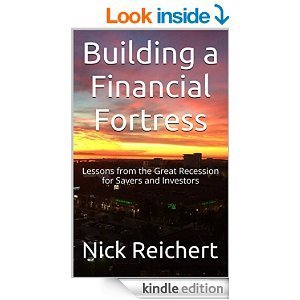 Click Here for Link to Kindle Store
Click Here for Link to Kindle StoreI'm very happy to announce I have just published my first book: "Building a Financial Fortress" on Kindle.
Print version will be available soon.
"This book is a re-publication of a blog I started in the depths of the Great Recession in March 2011. During that time, as I agonized over investing, saving and potential job loss, I developed an investment philosophy I dubbed the “Financial Fortress” and wrote a series of posts about it along with other posts about specific asset classes, investment strategies and related topics.
My two biggest successes have been in real estate and precious metals. During the Great Recession, I made some aggressive moves, using retirement savings, to purchase distressed condominiums in Orange County, California. In addition to enjoying positive cash flow while I owned the properties, I have just completed one sale and have a second one in escrow, doubling my money in five years. I also made an aggressive move into silver (US Silver Eagle coins) to watch them triple in value, at which time I sold individual rolls on EBay and kept the rest for future appreciation.
The essence of the Financial Fortress is that as savers and investors, we need to first have a strong defense before we can have a strong offense. As volatility in world markets seems to worsen each year and booms/busts become more intense, preservation of capital is paramount but so is finding opportunities to leverage what we have in order to grow our wealth."
Building A Financial Fortress

Published on June 29, 2014 16:19
June 1, 2014
Asset Class Review: Precious Metals Are Looking Attractive Again
 coin 50$ us gold (Photo credit: sprottmoney)Looking at the different types of investments available, stocks seem overvalued at the current market levels, so it's difficult to put new money there unless you have identified a particular company that looks poised for growth. Even then, it probably makes sense to trim your stock market exposure and remain broadly diversified. Bonds are worrisome with the threat of higher interest rates, however it looks like until the economy gets going and unemployment becomes less of an issue, the Fed will continue to keep rates low, which bodes well for borrowers; okay for bond investors who can at least earn a modest yield. Real estate seems to be enjoying a nice run-up in most markets, but is getting pricey. Precious metals had a tough year last year, but they are beginning to look like a buy.
coin 50$ us gold (Photo credit: sprottmoney)Looking at the different types of investments available, stocks seem overvalued at the current market levels, so it's difficult to put new money there unless you have identified a particular company that looks poised for growth. Even then, it probably makes sense to trim your stock market exposure and remain broadly diversified. Bonds are worrisome with the threat of higher interest rates, however it looks like until the economy gets going and unemployment becomes less of an issue, the Fed will continue to keep rates low, which bodes well for borrowers; okay for bond investors who can at least earn a modest yield. Real estate seems to be enjoying a nice run-up in most markets, but is getting pricey. Precious metals had a tough year last year, but they are beginning to look like a buy.Silver is looking very attractive at current prices of $18.80 per ounce and recently touching a low not seen in a year (see chart below). The investment thesis is still sound: the metal is consumed in industrial applications so as the economy improves so does demand. Also, silver has safe haven appeal and protection against declining value of the dollar, which even at low rates of inflation steadily erodes over time. A dollar now only buys about half of what it did in 1985, for example (see chart below).
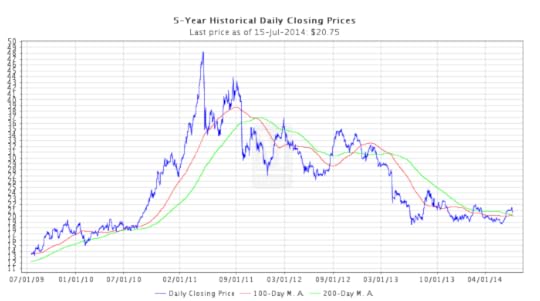
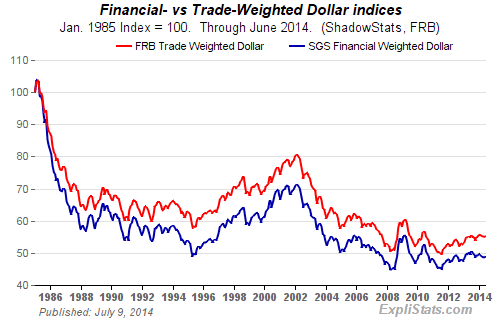
Gold is looking good as well (see chart below) and so is investment thesis as timeless store of value, safe haven and inflation hedge.
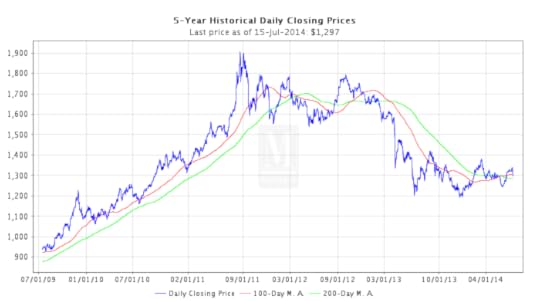
Although government statistics seem to say inflation is low and even "below target" from the Fed's point of view, the real story on inflation unfolds when you go to the gas station or grocery store, buy a car or pay rent.
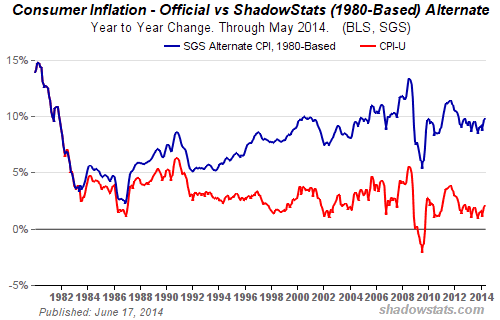
Other investment alternatives worth considering include early stage investing through a crowdfunding site. These do require you to be an accredited investor (i.e., net worth not including home over $1 million or earning more than $200K/year) and initial investment can be substantial and risk of loss is very high. If you have available funds, investing in one or two well-researched crowdfunding deals could add a nice lift to your portfolio down the road if the company is successful. There are several crowdfunding sites but only a few that allow you to invest for a return (vs. make a donation to a cause). One of the premier sites is Crowdfunder.
Disclosure: I own physical gold and silver as part of a broadly diversified investment portfolio.
Related articles
 Precious Metals Manipulation Isn't Hidden, IT'S RIGHT IN FRONT OF YOUR EYES!
Precious Metals Manipulation Isn't Hidden, IT'S RIGHT IN FRONT OF YOUR EYES!
 Rumblings in precious metals
Rumblings in precious metals
 Gold Report May 30 , 2014 -- Ed Steer's usual collection of News , data and views touching on gold and the precious metals ...... additional itms of note after " The Wrap "
Gold Report May 30 , 2014 -- Ed Steer's usual collection of News , data and views touching on gold and the precious metals ...... additional itms of note after " The Wrap "
 Gold And Silver - Debt Is Trouncing Precious Metals, For Now.
Gold And Silver - Debt Is Trouncing Precious Metals, For Now.


Published on June 01, 2014 17:29
March 2, 2014
Taxes
 Tax Day (Photo credit: LendingMemo)Tax Day - April 15 is coming up fast. I have used TurboTax for many years and have gotten to where I don't need to do the interview and I can just directly enter the information. A lot has changed since I first started using it - you can upload just about anything now, from your paycheck information, 1099's from investments, etc. without having to retype everything, which is really nice. I have also gotten to like the electronic filing and automatic deposit of refunds. I don't even print my tax return anymore - just save a pdf file on a disc and file it with the backup paperwork. It's always a little nerve-racking preparing the tax return because I'm never totally sure exactly what the refund or tax due will be. So many things can happen during a year and estimating the tax impact, especially if you have stock sales or other types of taxable transactions like sales of real property or other capital assets, can be challenging, even for a CPA. This is especially difficult if you are paid a salary and rely totally on tax withholding to cover your annual tax bill. This year was made more difficult by the new Obamacare taxes on investment income and higher Alternative Minimum Tax. Also, differences in the state taxation of Healthcare Spending Account contributions were a bit of a surprise to me. One thing that is clear is that taxes continue to rise and tax planning really needs to be a year-round process - not just something you do in December.
Tax Day (Photo credit: LendingMemo)Tax Day - April 15 is coming up fast. I have used TurboTax for many years and have gotten to where I don't need to do the interview and I can just directly enter the information. A lot has changed since I first started using it - you can upload just about anything now, from your paycheck information, 1099's from investments, etc. without having to retype everything, which is really nice. I have also gotten to like the electronic filing and automatic deposit of refunds. I don't even print my tax return anymore - just save a pdf file on a disc and file it with the backup paperwork. It's always a little nerve-racking preparing the tax return because I'm never totally sure exactly what the refund or tax due will be. So many things can happen during a year and estimating the tax impact, especially if you have stock sales or other types of taxable transactions like sales of real property or other capital assets, can be challenging, even for a CPA. This is especially difficult if you are paid a salary and rely totally on tax withholding to cover your annual tax bill. This year was made more difficult by the new Obamacare taxes on investment income and higher Alternative Minimum Tax. Also, differences in the state taxation of Healthcare Spending Account contributions were a bit of a surprise to me. One thing that is clear is that taxes continue to rise and tax planning really needs to be a year-round process - not just something you do in December. Related articles
 The Dark Side of Making More Money
The Dark Side of Making More Money
 W-2 Forms: Understanding Your Most Important Tax Document
W-2 Forms: Understanding Your Most Important Tax Document
 Turbo Tax 2014 Services Allow You To File Online
Turbo Tax 2014 Services Allow You To File Online
 Best Tax Software: TurboTax vs. H&R Block vs. TaxACT
Best Tax Software: TurboTax vs. H&R Block vs. TaxACT


Published on March 02, 2014 22:17
April 6, 2013
Stay Diversified - Resist Temptation
 Real Estate (Photo credit: wvhomes)Volatility returned to the markets this week with the US employment situation showing weakness, turning investors to bonds again for safety and resulting in a minor sell-off in the stock market.
Real Estate (Photo credit: wvhomes)Volatility returned to the markets this week with the US employment situation showing weakness, turning investors to bonds again for safety and resulting in a minor sell-off in the stock market.Again the best strategy seems to be a broadly diversified portfolio with no more than 20% in any one asset class (bonds, stocks, real estate, precious metals and cash).
I prefer not to worry about what's happening from day to day in the markets - trading is very difficult to do, even for those who are professionals.
Debt is the new currency, so leverage as much as you can in real estate while ensuring you have positive cash flow. I'm not a fan of leverage in situations where you can't cover the debt service with the cash flow from the asset. Leveraged investments in precious metals, for example, only work out if the underlying asset skyrockets in value and you sell your position. I much prefer leverage in real estate investments.
Lately, it has been very tempting to sell bonds, increase investments in stocks and real estate and minimize cash holdings. It is important to resist the temptation and stay diversified. At least this way if you suffer a loss in a particular asset class, you won't lose a large percentage of your portfolio.
I believe we are in a perpetual cycle of booms and busts that are driven by credit expansion. Each one is successively worse than the one before. I fear that the next boom and bust will be far worse than the "Great Recession" that we just experienced and indeed many still experience due to high unemployment and destruction of wealth that persist. This is why i favor a diversified approach and also lean toward hard assets (gold, silver, oil/gas real estate) versus financial assets (stocks, bonds, mutual funds) to protect and grow wealth, particularly when we are facing the threat of inflation - a consequence of global central back "easy money" policies.
Related articles
 CashNetUSA | Despite The Commercials, Gold Probably Isn�t a Good Investment - CashNetUSA
CashNetUSA | Despite The Commercials, Gold Probably Isn�t a Good Investment - CashNetUSA
 "Who should I blame next for the results of my actions?" - The Devil
"Who should I blame next for the results of my actions?" - The Devil
 Ilana Greene: Five Ways Investing in Real Estate Can Save You Money
Ilana Greene: Five Ways Investing in Real Estate Can Save You Money
 3 Investments Off the Beaten Path
3 Investments Off the Beaten Path
 4 Types of Investments - Paul Brenneke
4 Types of Investments - Paul Brenneke


Published on April 06, 2013 00:39
February 17, 2013
Maximize Cash Flow on Investment Property
 Subprime Crisis No Barrier to Affordable Housing (Photo credit: woodleywonderworks)If you own investment property, you know that positive cash flow is very important. Ideally, when you initially purchase the property, you enjoy positive cash flow at the outset. However, in some coastal markets you may end up with a property that breaks even or is slightly negative at first and so you need to work harder to get there.
Subprime Crisis No Barrier to Affordable Housing (Photo credit: woodleywonderworks)If you own investment property, you know that positive cash flow is very important. Ideally, when you initially purchase the property, you enjoy positive cash flow at the outset. However, in some coastal markets you may end up with a property that breaks even or is slightly negative at first and so you need to work harder to get there. Here is a list of ideas to improve investment property cash flow:
1) Raise the rent
Landlords are gaining in many markets as the economy covers and housing supply is constrained and you should be no differentKeep the increases modest (i.e., 2-3 percent annually) and it will be harder for tenants to want to moveIf you have a vacancy, be sure to price up as close as you can to market when re-leasing
2) Refinance
If you haven't already done so, refinancing is an easy way to improve monthly cash flowSome investment property is eligble for government programs (i.e., HARP) where loan to value ratio would not otherwise allow for a refinancingIf you purchased recently you may have to wait to build more equity since investment property can be purchased with 25% down but refinancing requires 30% equity4) Review liability insurancePeriodically check the market for insurance to see if you can get a lower rate on liability insuranceWhile you are at it, make sure your coverage is adequate5) Evaluate property managerCheck your property management company against the market - are they competitive in their fee structure?Are you happy with their performance?Get a few quotes and talk to some other companies6) Preventive maintenanceMake sure repairs, leaks and other issues are addressed immediatelyA few dollars spent today on preventive maintenance will save you bigger dollars down the roadGet a few quotes before doing the work - as the economy recovers, contractors are getting busier now and are able to raise their prices7) Other service providersPeriodically check the market for other service providers, such as landscape maintenance8) Review property taxesIf the value of your property has declined since you purchased it, you may be able to appeal the the value and thereby reduce your taxesMany jurisdictions have done this automatically in recent years but you should verify
Related articles
 Housing as an Investment? Yes, That Idea Is Back
Housing as an Investment? Yes, That Idea Is Back
 Financial Fortress - Hard Assets
Financial Fortress - Hard Assets
 Is it Finally Time to Short Long-Term US Treasury Bonds?
Is it Finally Time to Short Long-Term US Treasury Bonds?


Published on February 17, 2013 17:13
February 4, 2013
Credit Supernova!
Great piece by Bill Gross on the unprecedented credit expansion which will lead to inflation:
http://www.pimco.com/EN/Insights/Page...
http://www.pimco.com/EN/Insights/Page...

Published on February 04, 2013 20:27
January 13, 2013
Is it Finally Time to Short Long-Term US Treasury Bonds?
I have written in the past about TBT (ProShares UltraShort Lehman 20), a leveraged inverse exchange traded fund that is designed to achieve returns that are inverse to and double the increase or decrease in the 20+ year US Treasury Bond index. For example, if the index decreases 1%, this ETF should go up 2%. When the Treasury rally ends and the sell-off begins, this will be a very powerful tool to achieve outstanding returns as interest rates rise and bond prices plummet.
However as you can see in the chart below, the continuing rally in long-dated Treasury bonds since the financial crisis - Federal Reserve interest rate manipulation, "flight to safety" and investor uncertainty/fear - has resulted in a significant decline in the value of TBT.
Many investors who sensed for the past year or two that this is a "no brainer" bet have been burned by another leg down. I still believe this is the next "big short," but as with any time you are betting on the decline in the value of an asset pumped up into a bubble, timing is everything.
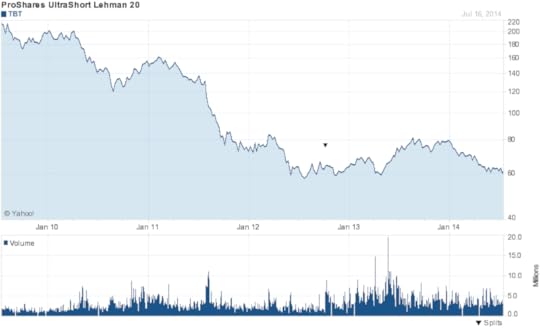 TBT - Time to Buy?Why is this time any different?
TBT - Time to Buy?Why is this time any different? Well, for one thing, more and more market observers are noticing investors putting money into stocks. For the last three weeks, equity mutual fund inflows have been almost $25 billion, far exceeding bond inflows. Many individual investors, tired of earning minimal returns in fixed income securities and seeing how well the stock market performed last year have decided to jump back into the market. Many were waiting for resolution of the "Fiscal Cliff" to do so. Also, the economic recovery, albeit weak, continues which bodes well for continued strength in the stock market.
Secondly, as I have written many times before, the easy money policies of the Federal Reserve will light the fire of inflation - it's not a question of "if" but rather "when" the inflation shows up and how much it is. While the Consumer Price Index has shown relatively benign readings lately, many believe this index is manipulated and certainly doesn't reflect reality since it excludes food and oil. The methodology of calculating the CPI has also changed over the years, resulting in lower readings that you would otherwise have if the methodology were kept constant. If you've been to the grocery store or the gas station lately, you know that these items are not getting any cheaper. As you can see in the chart below, one estimate is that we are at roughly 10% inflation now. What is more troubling is that the gap between reported and the alternate measure is widening.

The Fiscal Cliff deal hasn't addressed the annual US budget deficit or the enormous - over $16 trillion - public debt of the United States. The threat of further credit downgrades of the United States coupled with the uncertainty of any real meaningful approach to reducing the public debt will weigh on the price of Treasuries. Indeed, the easiest way to deal with the US public debt is to devalue the dollar.
Finally, the biggest concern for inflation is the huge supply of money that has been created over the past few years. There is now over $2.4 trillion in the banking system available to lend to individuals and businesses. More than $1.2 trillion has been added to the money supply since the beginning of the financial crisis (almost doubled). When this starts to go to work in the real economy, the flood of dollars will be a very powerful driver of the economy, as well as inflation.
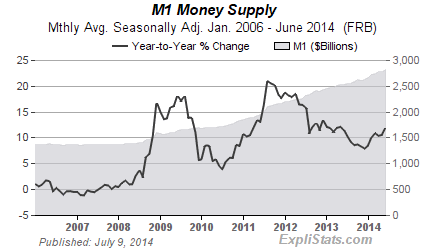
I do not currently have a position in TBT.
Related articles
 Gross Raises Treasuries to Highest Level Since July
Gross Raises Treasuries to Highest Level Since July
 Beware The Sharp Rise In Treasury Yields (GS, TBT, TLT, MORT, XHB)
Beware The Sharp Rise In Treasury Yields (GS, TBT, TLT, MORT, XHB)
 Treasuries Rise Before Fed Purchases as Selloff Brings Buyers - Bloomberg
Treasuries Rise Before Fed Purchases as Selloff Brings Buyers - Bloomberg
 The Bull Trap in Bonds Has Been Set!
The Bull Trap in Bonds Has Been Set!


Published on January 13, 2013 16:32
December 28, 2012
Don't Quit
Sharing this poem that my grandfather gave me when I was a kid. Not sure who the author is.
It says a lot in a very simple way:
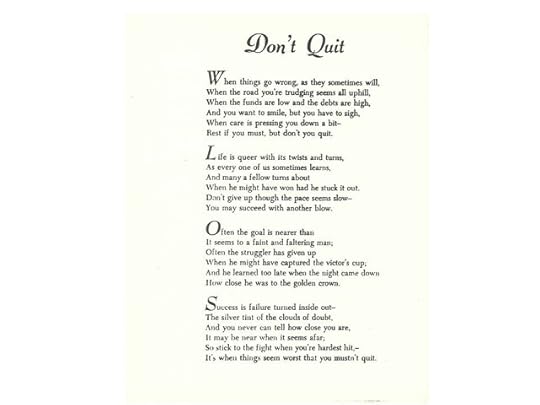

It says a lot in a very simple way:


Published on December 28, 2012 21:42



